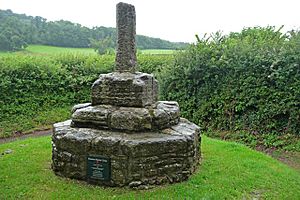Dunster Butter Cross facts for kids
Quick facts for kids Butter Cross |
|
|---|---|
 |
|
| Location | Dunster, Somerset, England |
| Built | 15th century |
|
Listed Building – Grade II*
|
|
| Official name: Butter Cross | |
| Designated | 22 May 1969 |
| Reference no. | 1345602 |
| Official name: Butter Cross at Dunster | |
| Designated | 18 March 1996 |
| Reference no. | 1014409 |
| Lua error in Module:Location_map at line 420: attempt to index field 'wikibase' (a nil value). | |
The Butter Cross in Dunster, Somerset, England, is a very old and important structure. It's officially recognized as a Grade II* listed building and an ancient monument. This cross was first built a long time ago, in the late 1300s or early 1400s. It used to stand in the main street of Dunster. Later, in the late 1700s or early 1800s, it was moved to where it is now. Even though the very top part of the cross is gone, the main pole and its base are still the originals. The Butter Cross is looked after by English Heritage and managed by the National Trust.
Contents
What is a Butter Cross?
Why is it Called a Butter Cross?
The name "Butter Cross" comes from its use in old market places. People from nearby villages would gather around these crosses. They came to buy fresh, local products like butter, milk, and eggs. Farmers would display their goods on the wide, stepped bases of the cross.
The Dunster Market
The market in Dunster was very popular. People traveled from towns like Taunton and Bodmin to trade here. The Dunster Butter Cross was built between the late 1300s and early 1400s. It first stood in the High Street, possibly near the Yarn Market. In 1461, it was known as the "high cross." By 1689, people started calling it the "Butter Cross."
Moving the Cross
The cross was moved to its current spot on St George's Street, at the edge of the village. We don't know the exact date it was moved. In 1776, workers paid by Henry Fownes Luttrell leveled the ground where the cross now stands. It might have been moved then. Another local story says it was moved in 1825. However, a drawing by the famous artist J. M. W. Turner from 1811 shows it was already in its current place by that time.
Who Looks After It?
Today, the Dunster Butter Cross is cared for by English Heritage. It is managed by the National Trust. These organizations help protect important historical sites for everyone to enjoy.
How the Cross Looks
The Butter Cross has a main pole, called a shaft, and a base stone. The base is shaped like an octagon, and the shaft is polygonal. The very top part of the cross is missing. It stands on a small area of raised ground. The base stone is about 0.85 meters (2.8 feet) wide and 0.5 meters (1.6 feet) high. The remaining shaft is 1.1 meters (3.6 feet) tall. It changes from a square shape to an octagonal shape as it goes up. On the northern side, there's an inscription that says "WC, 1871, WS." This marks a time when the cross was repaired or restored.

